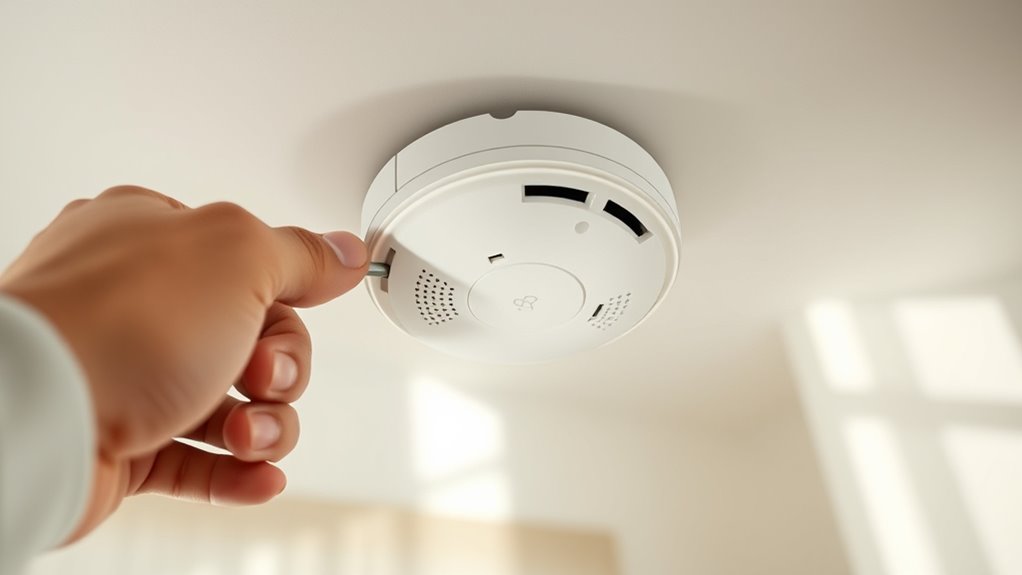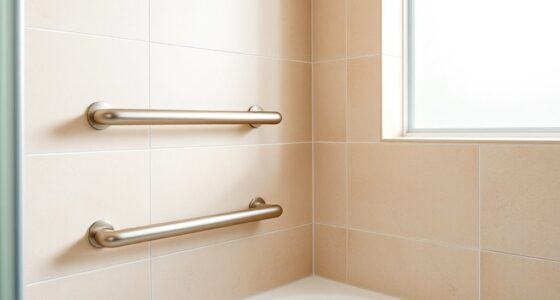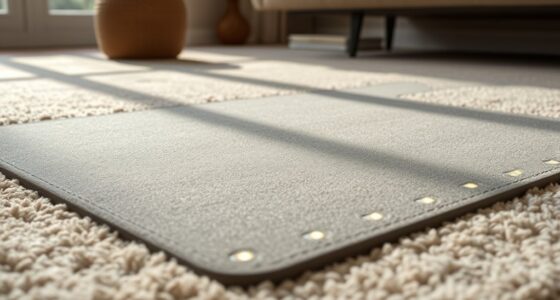To guarantee your home stays safe, install smoke detectors inside bedrooms, outside sleeping areas, and on every level, including basements. Mount alarms high on walls or ceilings, at least 10 feet from cooking areas, and away from drafts like vents or windows. Test them monthly, clean twice a year, and replace the units every 10 years for maximum safety. Upgrading to smart systems adds advanced detection and emergency alerts—learn more to maximize your fire safety.
Key Takeaways
- Install smoke alarms inside bedrooms, outside sleeping areas, and on every level, including basements, following NFPA 72 standards.
- Test alarms monthly and clean them twice a year to ensure proper functioning and to remove dust or debris.
- Replace batteries annually or immediately if alarms chirp; replace entire units every 10 years or sooner if malfunctioning.
- Use smart or interconnected smoke detectors for early warning, real-time alerts, and automated emergency responses.
- Follow local fire safety regulations and manufacturer instructions for placement, maintenance, and replacement to ensure optimal safety.
Proper Placement of Smoke Alarms in Your Home
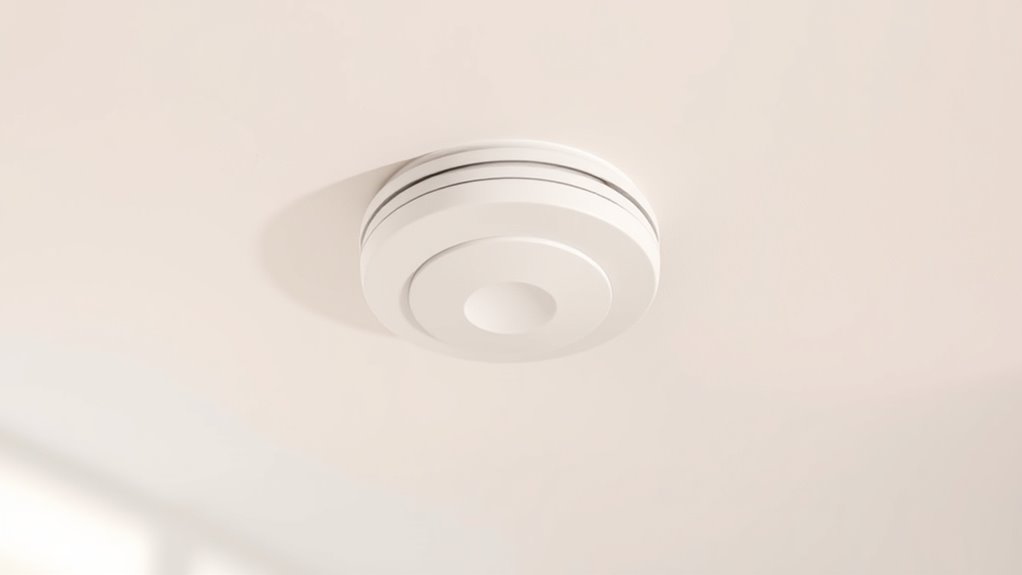
To guarantee your smoke alarms provide reliable protection, proper placement is essential. You should install smoke alarms inside bedrooms, outside sleeping areas, and on every level of your home, including the basement, to ensure thorough fire detection. Mount alarms high on walls or ceilings—within 12 inches of the ceiling when wall-mounted—and near the peak in vaulted or pitched ceilings. Position alarms at least 10 feet away from cooking appliances to reduce false alarms caused by kitchen smoke or steam. Avoid placing them near windows, doors, vents, or ducts where drafts could interfere with detection. Keep alarms unobstructed, unpainted, and ensure they’re positioned so smoke can rise freely. Proper placement maximizes home safety and minimizes maintenance issues, safeguarding your home effectively. Additionally, understanding optimal angles for pinball machines can help in creating a fun and engaging game room environment, ensuring safety and enjoyment. Regular testing and battery maintenance are also crucial to ensure your smoke alarms function properly over time. For added safety, consider appliance testing protocols to verify that no electrical faults can compromise your smoke detection system. Ensuring proper alarm placement can also prevent nuisance alarms and improve overall fire safety.
Installation Guidelines for Effective Smoke Detection
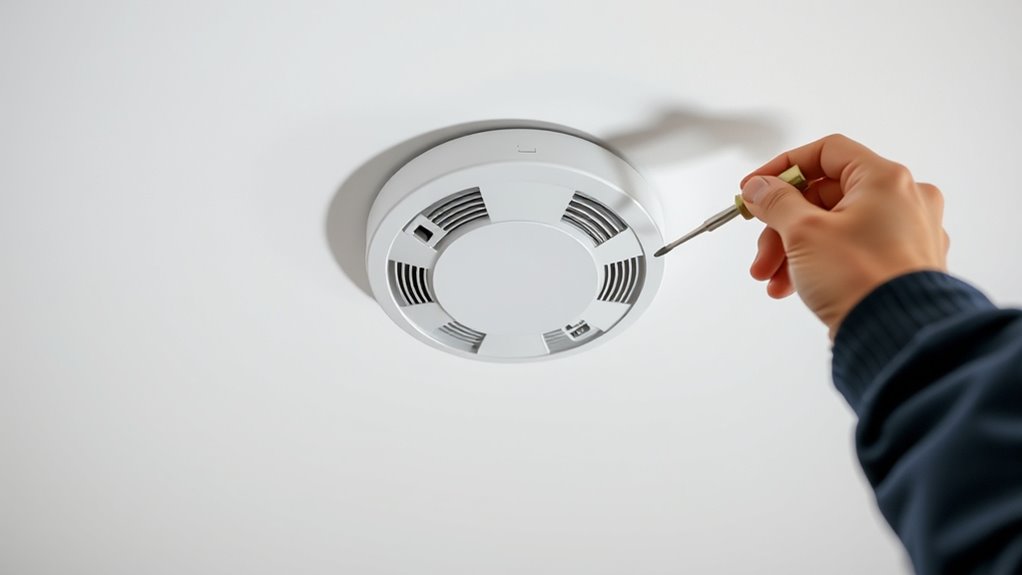
Proper installation of smoke alarms guarantees they function reliably when needed. Follow NFPA 72 standards for *ideal* placement to enhance fire detection and home safety. Mount smoke alarms high on walls or ceilings—within 12 inches of the ceiling for wall units and within 3 feet of the peak of pitched ceilings. Keep them at least 10 feet away from cooking appliances to reduce false alarms. Avoid placing alarms near windows, doors, vents, or drafty areas, which can interfere with proper positioning. Never paint or decorate smoke alarms, and always follow manufacturer instructions for installation. To visualize placement, consider this:
| Location | Placement Tip | Purpose |
|---|---|---|
| Inside bedrooms | Near sleeping areas | Early fire detection |
| Outside bedrooms | Outside sleeping zones | Clear alert during sleep |
| Every level | Near stairways and hallways | Complete home protection |
| Basements | On each level’s ceiling or wall | Effective fire detection |
Additionally, placing smoke detectors near heating sources can help ensure early warning in case of fire. Regular maintenance, including cleaning and replacing batteries, is essential for reliable operation to prevent malfunctioning alarms. Proper maintenance and regular testing are essential for reliable operation.
Routine Testing and Maintenance Procedures
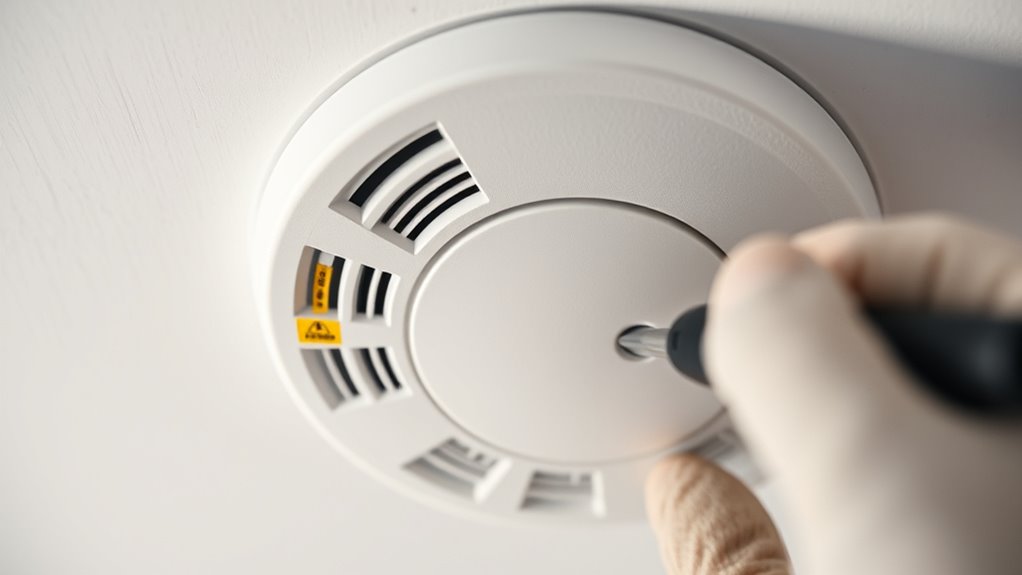
Regular testing and maintenance are essential to guarantee your smoke alarms function correctly when every second counts. You should test your smoke detector monthly by pressing the test button for at least five seconds to ensure it’s working properly. Clean your alarms twice a year with a vacuum or soft brush to remove dust and debris that can impair functionality. Check the batteries regularly; replace them annually or immediately if the alarm chirps, indicating low power. For alarms with non-replaceable batteries, replace the entire unit every 10 years or sooner if it malfunctions. Follow the manufacturer’s instructions for maintenance to keep your smoke detector reliable and ensure your safety. Proper upkeep helps prevent false alarms and ensures alert readiness in emergencies. Utilizing AI-powered technology in safety devices can enhance detection accuracy and maintenance alerts. Additionally, ensure your smoke detector is installed in suitable locations around your home to maximize coverage and early warning capabilities. Regularly inspecting the composition of alarm sensors can help identify potential issues before they compromise safety. Incorporating indoor air quality awareness can also support overall safety by reducing pollutant buildup that may affect detector performance. Staying informed about smoke detector technology advancements can help you choose more effective safety solutions for your home.
Replacing Batteries and Upgrading Smoke Alarms

Replacing batteries promptly and upgrading your smoke alarms are essential steps to maintain reliable fire detection. Regular battery replacement ensures your smoke alarms stay operational, especially since most alarms chirp or warn when batteries are low. Consider using lithium or sealed 10-year batteries to reduce maintenance and avoid frequent replacements. When upgrading smoke alarms, choose models with longer lifespan and adhere to safety regulations for detector installation. Proper alarm testing after battery changes is crucial for effective smoke detector maintenance. Remember, smoke alarm lifespan typically lasts around 10 years, so replacing the entire unit at that point is vital for home fire safety. Always follow manufacturer instructions for battery types, alarm testing, and disposal, ensuring your system remains dependable. Understanding modern art influences can help homeowners appreciate the importance of integrating advanced technology into home safety devices. Additionally, performing regular inspections can help identify potential issues early and ensure your smoke detection system functions optimally. Incorporating smart smoke detectors with Wi-Fi connectivity can further enhance your home safety by providing real-time alerts and easier maintenance. Regularly checking for certifications and endorsements can also verify the reliability and effectiveness of your smoke alarm system. Moreover, choosing alarms with interconnectivity features can ensure that all detectors activate simultaneously in case of a fire, increasing safety.
Enhancing Safety With Smart Alarm Systems
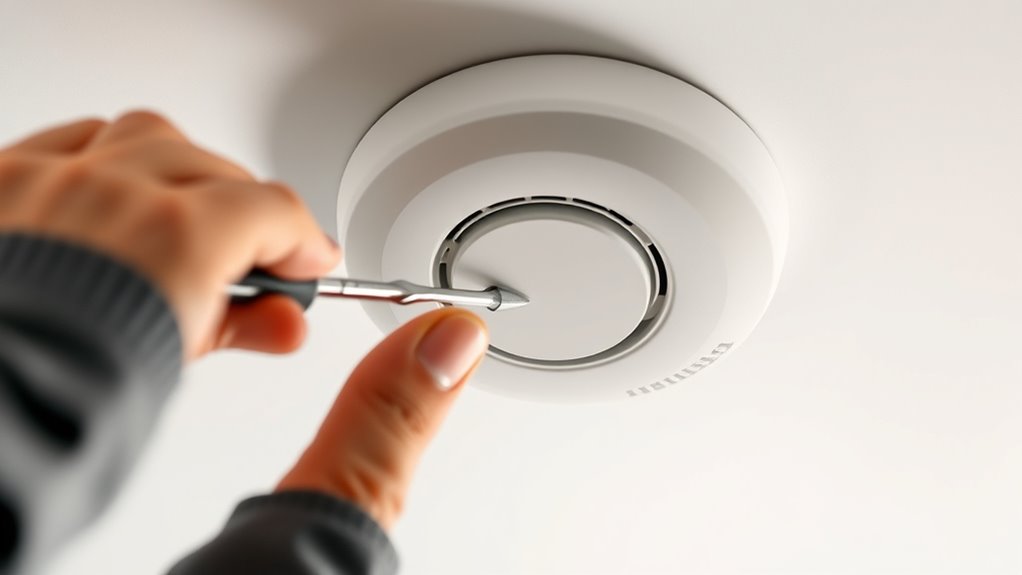
Smart alarm systems like Arlo considerably enhance home safety by providing real-time alerts and automated responses. Interconnected smoke alarms guarantee all devices sound simultaneously, offering thorough coverage across your home. These smart alarm systems listen for smoke alarm sounds and send emergency notifications directly to your smartphone, enabling quicker response times. Expertise spans various architectural needs and integration with smart home platforms can further optimize safety management. They can automatically notify emergency services when smoke is detected, even if you’re away, reducing response delays. AI-powered sensors also distinguish between false alarms and real fires, minimizing unnecessary disruptions. Regular maintenance and updates improve fire detection accuracy, while integration with home automation platforms streamlines safety management. Proper smoke alarm installation combined with smart technology ensures reliable fire detection, keeping your home and loved ones safer at all times. Additionally, understanding fire safety regulations can help ensure your system complies with local standards. Incorporating fire detection systems that utilize advanced sensors can further enhance early warning capabilities. Moreover, fostering a safety-conscious mindset among household members can improve overall emergency preparedness.
Frequently Asked Questions
Where Should Your Smoke Detector Be Placed?
You should place your smoke detector inside each bedroom, outside sleeping areas, and on every level of your home, including the basement.
Mount them high on walls or ceilings—within 12 inches of the ceiling on walls and within 3 feet of the peak on vaulted ceilings.
Keep them at least 10 feet away from your stove and avoid placing near windows, vents, or doors to prevent false alarms.
What’s the Code for Smoke Detector Placement?
The code for smoke detector placement, according to NFPA 72, requires you to install alarms inside bedrooms, outside sleeping areas, and on every level of your home.
You should mount them on the ceiling or high on walls, within 12 inches of the ceiling.
For vaulted ceilings, place them within 3 feet of the peak but not at the apex.
Make sure to avoid drafts near windows, doors, or ducts.
What Are Three Key Placement Guidelines for the Location of Smoke Detectors?
When considering where to place smoke detectors, focus on three key guidelines.
First, install them inside bedrooms, outside sleeping areas, and on every home level.
Second, mount detectors high on walls or ceilings, especially in vaulted or pitched ceilings.
Lastly, keep detectors at least 10 feet from cooking appliances and avoid drafty spots like near windows, vents, or doors, to guarantee they work effectively and avoid false alarms.
Where Should Smoke Detection Be Located?
You should install smoke detectors inside each bedroom, outside sleeping areas, and on every level of your home, including basements.
Mount them high on walls or ceilings—within 12 inches if wall-mounted—and near the ceiling if ceiling-mounted.
Keep detectors at least 10 feet from kitchens to avoid false alarms, and avoid placing them near windows, vents, or drafts that could affect their performance.
Conclusion
By following proper placement, regular testing, and timely upgrades, you can substantially improve your home’s safety. Imagine a family who installed smoke alarms in key areas and tested them monthly; when a small fire started, the alarms alerted everyone instantly, preventing disaster. Taking these simple steps ensures you’re prepared and protected. Keep your alarms in top shape, and you’ll have peace of mind knowing you’re doing everything you can to keep your loved ones safe.
